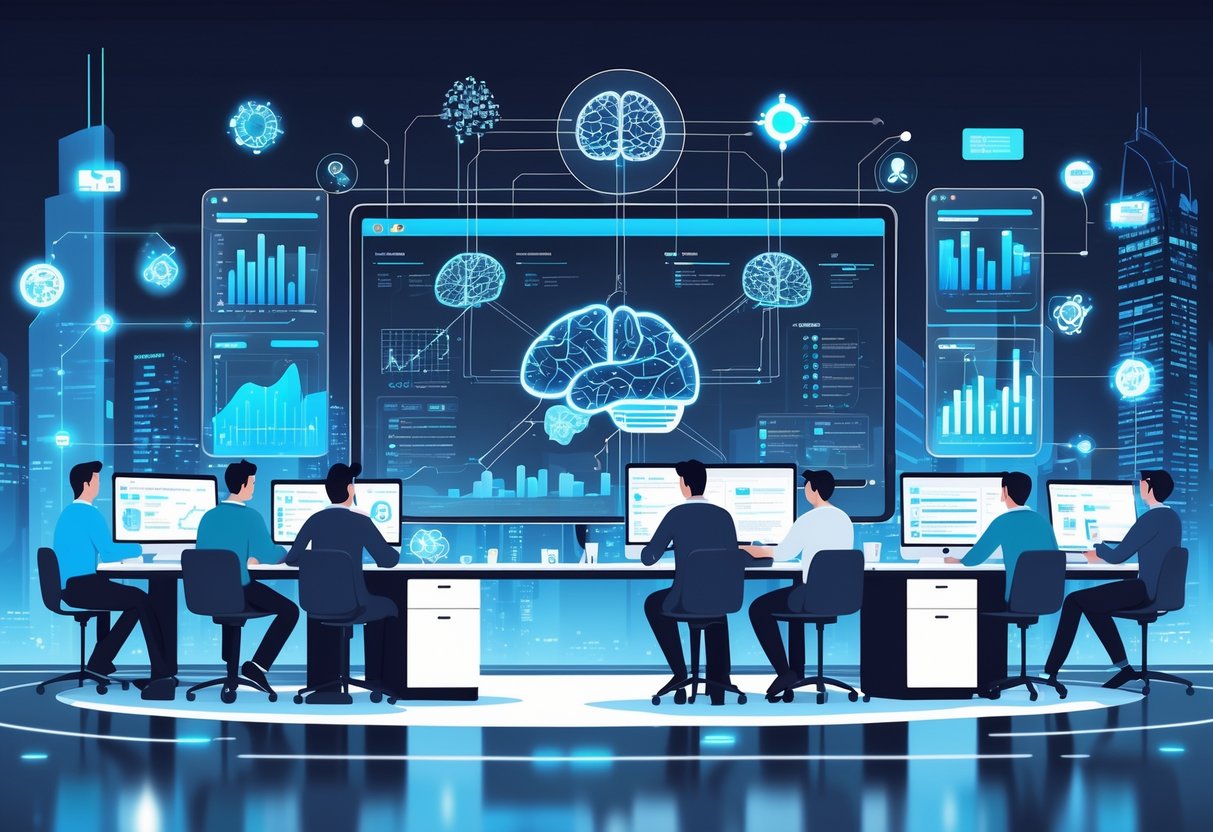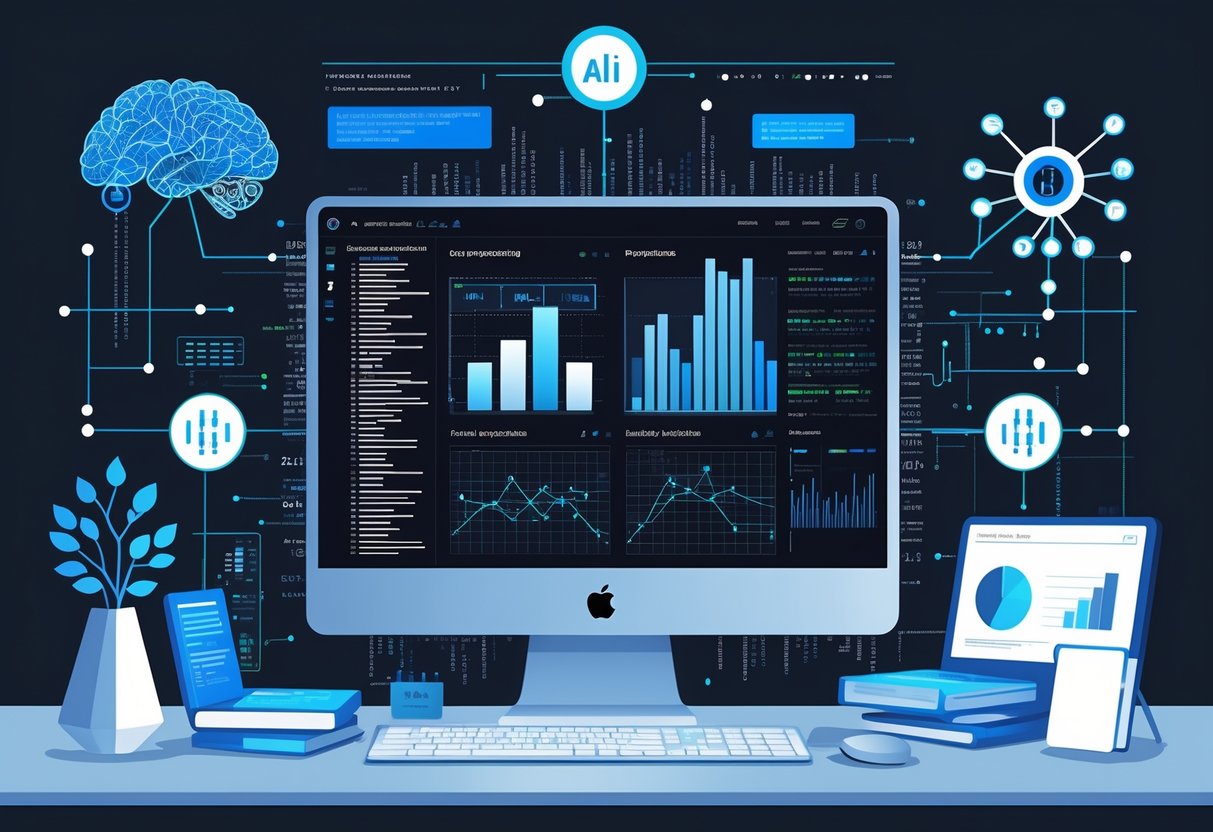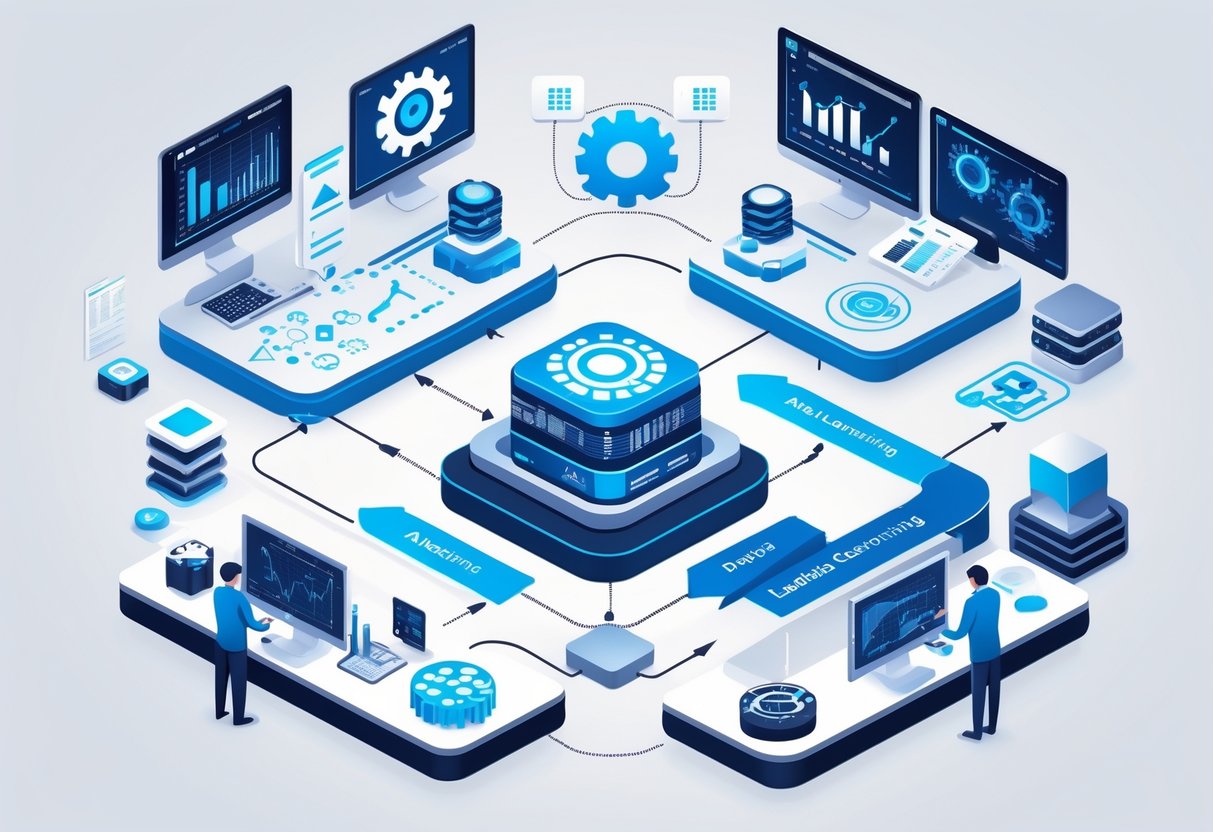Analytics engineers today face increasing pressure to understand AI and machine learning as these technologies reshape how data teams work. Mastering AI and ML fundamentals enables analytics engineers to build smarter data pipelines, create predictive models, and deliver insights that drive business decisions. The intersection of traditional analytics engineering with modern AI techniques creates new opportunities for professionals who understand both domains.

The journey from analytics engineering to AI implementation requires understanding core machine learning concepts, programming foundations, and deployment strategies. Foundations of AI and machine learning courses provide structured learning paths that cover essential infrastructure components, data processing techniques, and model deployment practices. Analytics engineers can leverage their existing SQL and data modeling skills while expanding into Python programming and statistical methods.
Modern AI tools and frameworks have made machine learning more accessible to analytics professionals than ever before. Google Cloud’s machine learning training programs offer hands-on experience with real-world technologies that analytics engineers encounter in production environments. The combination of traditional analytics skills with AI knowledge positions professionals to tackle complex data challenges and advance their careers in the evolving data landscape.
Key Takeaways
- Analytics engineers can build on existing data skills to master AI and machine learning fundamentals through structured learning programs
- Understanding machine learning lifecycle processes and modern AI architectures enables better data pipeline design and predictive analytics implementation
- Hands-on projects with cloud platforms and certification programs provide career advancement opportunities in the growing AI engineering field
Core Principles of AI and Machine Learning

Artificial intelligence and machine learning form the foundation of modern data analytics systems. These technologies enable computers to learn patterns from data, make predictions, and automate complex decision-making processes that analytics engineers rely on daily.
Defining Artificial Intelligence and Machine Learning
Artificial intelligence refers to computer systems that can perform tasks typically requiring human intelligence. These tasks include recognizing speech, making decisions, and solving problems.
AI systems can follow pre-programmed rules or learn from experience. They process large amounts of data to identify patterns and make predictions.
Machine learning is a subset of artificial intelligence. Machine learning is the basis for most modern artificial intelligence solutions and focuses on algorithms that improve automatically through experience.
ML systems build mathematical models using training data. They make predictions or decisions without being explicitly programmed for each specific task.
The key difference lies in scope. AI encompasses all computer systems that mimic human intelligence, while ML specifically refers to systems that learn and adapt from data.
Key Concepts and Terminology in AI and ML
Algorithms are the mathematical instructions that power machine learning models. They process input data and produce outputs based on learned patterns.
Training data consists of examples used to teach ML models. The quality and quantity of training data directly impacts model performance.
Features are individual measurable properties of observed phenomena. In a dataset about houses, features might include square footage, number of bedrooms, and location.
Models are the mathematical representations created after training algorithms on data. They capture patterns and relationships within the training data.
Predictions are outputs generated when models process new, unseen data. Analytics engineers use these predictions to inform business decisions.
Overfitting occurs when models learn training data too specifically and fail to generalize to new data. Underfitting happens when models are too simple to capture underlying patterns.
Types of Machine Learning: Supervised, Unsupervised, and Reinforcement
Supervised learning uses labeled training data to learn mappings between inputs and desired outputs. The algorithm learns from examples where the correct answer is known.
Common supervised learning tasks include:
- Classification: Predicting categories (spam vs. not spam)
- Regression: Predicting continuous values (house prices, sales forecasts)
Unsupervised learning finds hidden patterns in data without labeled examples. The algorithm explores data structure without knowing the correct answers.
Key unsupervised learning techniques include:
- Clustering: Grouping similar data points together
- Dimensionality reduction: Simplifying data while preserving important information
- Association rules: Finding relationships between different variables
Reinforcement learning trains algorithms through interaction with an environment. The system learns by receiving rewards or penalties for different actions.
This approach works well for sequential decision-making problems. Examples include game playing, robotics, and automated trading systems where the algorithm must learn optimal strategies through trial and error.
Essential Programming and Data Foundations

Analytics engineers need strong programming skills in Python, expertise with data structures and manipulation techniques, and a solid understanding of statistical concepts that power machine learning algorithms.
Python for Analytics Engineers
Python serves as the primary programming language for analytics engineers working with AI and machine learning systems. The language provides essential libraries and frameworks needed for data processing and model development.
Analytics engineers must master core Python concepts including variables, functions, loops, and conditional statements. These fundamentals enable effective data manipulation and automated processing workflows.
Key Python libraries include:
- pandas – Data manipulation and analysis
- NumPy – Numerical computing and arrays
- matplotlib – Data visualization
- scikit-learn – Machine learning algorithms
Analytics engineers should focus on writing clean, readable code that follows Python best practices. Understanding object-oriented programming concepts helps when working with complex data pipelines and machine learning frameworks.
Data Structures and Manipulation
Effective data manipulation requires understanding different data structures and their appropriate use cases. Analytics engineers work with structured and unstructured data from various sources.
Common data structures include:
| Structure | Use Case | Python Implementation |
|---|---|---|
| Lists | Sequential data | [1, 2, 3, 4] |
| Dictionaries | Key-value pairs | {'name': 'John', 'age': 30} |
| DataFrames | Tabular data | pandas.DataFrame() |
| Arrays | Numerical computations | numpy.array() |
Data cleaning represents a critical skill for analytics engineers. This process involves handling missing values, removing duplicates, and standardizing data formats across different sources.
Analytics engineers must understand data transformation techniques including filtering, grouping, and aggregating large datasets. These operations prepare raw data for machine learning algorithms and analytical models.
The pandas library provides powerful tools for data manipulation including merge operations, pivot tables, and time series analysis. Mastering these functions enables efficient processing of complex datasets.
Fundamental Statistics for Machine Learning
Statistical knowledge forms the mathematical foundation for understanding machine learning algorithms and interpreting model results. Analytics engineers need this background to make informed decisions about model selection and evaluation.
Essential statistical concepts include:
- Descriptive statistics – Mean, median, mode, standard deviation
- Probability distributions – Normal, binomial, Poisson distributions
- Hypothesis testing – Statistical significance and p-values
- Correlation and regression – Relationship analysis between variables
Understanding sampling distributions helps analytics engineers work with representative data subsets and avoid biased conclusions. This knowledge proves crucial when dealing with large datasets where complete analysis isn’t feasible.
Statistical inference enables analytics engineers to draw meaningful conclusions from data analysis. This includes confidence intervals, significance testing, and understanding when results can be generalized to broader populations.
Analytics engineers should understand how statistical assumptions affect model performance and accuracy. This knowledge helps identify when models may produce unreliable results due to data quality issues or inappropriate algorithm selection.
Machine Learning Lifecycle and Analytics Engineering

Analytics engineers work closely with data scientists and machine learning engineers throughout each phase of the model lifecycle. They build data pipelines that feed model training, create infrastructure for model evaluation, and establish deployment workflows that integrate ML predictions into business systems.
Data Acquisition and Preprocessing
Analytics engineers design and maintain the data infrastructure that powers machine learning projects. They build automated pipelines that collect data from multiple sources including databases, APIs, and streaming platforms.
Data Pipeline Architecture
- Extract data from operational systems
- Transform raw data into training-ready formats
- Load processed data into feature stores
- Implement data quality checks and validation rules
The data preparation phase requires extensive cleaning and processing work. Analytics engineers create reproducible workflows that handle missing values, remove outliers, and standardize data formats.
They work with data scientists to engineer features that improve model performance. This includes creating aggregations, calculating rolling averages, and generating derived metrics from raw data.
Key Responsibilities:
- Build ETL pipelines for model training data
- Implement data versioning for reproducible experiments
- Create automated data quality monitoring
- Design feature engineering workflows
Analytics engineers also establish data governance practices. They ensure data lineage tracking, implement access controls, and maintain documentation for all data sources used in ML projects.
Model Development and Evaluation
During the model engineering phase, analytics engineers provide the infrastructure that data scientists need for experimentation and evaluation. They set up model training environments and implement experiment tracking systems.
Infrastructure Components:
- Model training compute resources
- Experiment tracking databases
- Model artifact storage systems
- Automated testing frameworks
Analytics engineers create standardized workflows for model validation. They build automated systems that test models against historical data and compare performance metrics across different model versions.
They implement cross-validation frameworks that help data scientists evaluate model robustness. These systems automatically split data into training and testing sets while maintaining data integrity.
Evaluation Support:
- Automated model performance testing
- Statistical significance testing infrastructure
- Model comparison dashboards
- Performance monitoring alerts
Machine learning engineers rely on these evaluation systems to make informed decisions about model deployment. Analytics engineers ensure that all model metrics are tracked consistently and results are reproducible.
Model Deployment in Production
Analytics engineers bridge the gap between model development and production systems. They create the infrastructure needed for model deployment and ongoing monitoring in live environments.
Deployment Infrastructure:
- Model serving APIs and endpoints
- Real-time feature computation pipelines
- Prediction result storage systems
- Rollback and versioning mechanisms
They implement automated deployment pipelines that move models from development to production safely. These pipelines include testing stages that validate model performance before full deployment.
Analytics engineers design monitoring systems that track model performance in production. They create alerts for data drift, prediction accuracy changes, and system performance issues.
Production Monitoring:
- Model prediction accuracy tracking
- Data drift detection systems
- System performance monitoring
- Business impact measurement
Machine learning engineers depend on these monitoring systems to maintain model quality over time. Analytics engineers ensure that production models continue performing as expected and flag issues that require model retraining or updates.
Modern AI Techniques and Architectures

Analytics engineers work with three core AI technologies that power today’s intelligent systems. Deep learning networks process complex data patterns, large language models generate human-like text, and retrieval-augmented generation combines stored knowledge with AI responses.
Deep Learning and Neural Networks
Deep learning uses artificial neural networks with multiple layers to learn complex patterns from data. Each layer processes information and passes it to the next layer, similar to how the human brain works.
Neural networks excel at three main tasks:
- Image recognition and computer vision
- Natural language processing
- Pattern detection in large datasets
The architecture consists of input layers that receive data, hidden layers that process information, and output layers that produce results. Analytics engineers use frameworks like TensorFlow and PyTorch to build these networks.
Training requires large amounts of data and significant computing power. The network adjusts its internal weights through a process called backpropagation. This allows it to improve accuracy over time.
Common types include:
- Convolutional Neural Networks (CNNs) for image analysis
- Recurrent Neural Networks (RNNs) for sequential data
- Transformer networks for language tasks
Large Language Models (LLM) Overview
Large language models are AI systems trained on massive amounts of text data to understand and generate human-like language. These models contain billions or trillions of parameters that help them process complex language patterns.
Key characteristics of modern LLMs:
- Pre-trained on diverse text sources
- Fine-tuned for specific tasks
- Capable of few-shot learning
Popular models include GPT-4, Claude, and Llama. Each model has different strengths for various applications like code generation, content creation, or data analysis.
Analytics engineers use LLMs through APIs or hosted services. The models can help with data documentation, query generation, and report summarization.
Training involves two main phases:
- Pre-training on large text corpora
- Fine-tuning on specific datasets
LLMs understand context through attention mechanisms. This allows them to maintain coherent responses across long conversations and complex prompts.
Retrieval-Augmented Generation (RAG) Explained
RAG combines the power of large language models with external knowledge sources to provide more accurate and up-to-date responses. This technique addresses the limitation of LLMs having knowledge cutoff dates.
The process works in three steps. First, the system searches a knowledge base for relevant information. Second, it retrieves the most relevant documents or data points. Third, it feeds this information to an LLM to generate a response.
RAG architecture components:
- Document store containing reference materials
- Vector database for semantic search
- Retrieval system to find relevant content
- Generation model to create responses
Analytics engineers implement RAG systems to answer questions about company data, documentation, or domain-specific knowledge. The technique works well for technical support, data governance, and business intelligence applications.
Benefits include:
- Access to current information
- Reduced hallucinations from the LLM
- Traceable sources for answers
- Lower computational costs than retraining models
Vector embeddings enable semantic search within the knowledge base. This allows the system to find conceptually similar content even when exact keywords don’t match.
Hands-On Projects and Practical Applications

Analytics engineers build expertise through project-based learning that mirrors real industry challenges. They develop portfolios featuring data pipeline automation, predictive analytics dashboards, and customer segmentation models that demonstrate practical machine learning implementation skills.
Project-Based Learning Strategies
Analytics engineers learn most effectively by building complete end-to-end systems. They start with simple data preprocessing tasks and gradually advance to complex machine learning pipelines.
Structured Learning Path:
- Week 1-2: Data cleaning and exploratory analysis projects
- Week 3-4: Basic prediction models using regression
- Week 5-6: Classification problems with real datasets
- Week 7-8: Advanced feature engineering techniques
They should focus on hands-on machine learning projects that cover practical applications. Each project builds upon previous skills while introducing new concepts.
The most effective approach involves working with messy, real-world datasets rather than clean academic examples. Analytics engineers encounter missing values, inconsistent formats, and incomplete records in actual business environments.
They benefit from comprehensive programs with hands-on experience that combine theoretical knowledge with practical implementation. This approach prepares them for dynamic AI and ML challenges.
Real-World Use Cases in Analytics
Analytics engineers apply machine learning across multiple industries within the digital economy. They build recommendation systems for e-commerce platforms, fraud detection models for financial services, and demand forecasting tools for supply chain optimization.
Common Industry Applications:
| Industry | Use Case | Key Techniques |
|---|---|---|
| E-commerce | Product recommendations | Collaborative filtering, content-based filtering |
| Healthcare | Patient risk assessment | Classification, time series analysis |
| Finance | Credit scoring | Ensemble methods, feature selection |
| Manufacturing | Predictive maintenance | Anomaly detection, sensor data analysis |
They create customer segmentation models that identify high-value prospects and churn prediction systems that reduce customer attrition. These projects directly impact business revenue and operational efficiency.
Analytics engineers also develop automated reporting dashboards that transform raw data into actionable insights. They integrate machine learning models with business intelligence tools to provide real-time analytics capabilities.
The digital economy demands professionals who can bridge technical implementation with business requirements. They translate complex algorithms into practical solutions that stakeholders can understand and use.
Building Your Project Portfolio
Analytics engineers showcase their skills through diverse project portfolios that demonstrate technical depth and business impact. They document each project with clear problem statements, methodology explanations, and measurable results.
Essential Portfolio Components:
- Data Pipeline Project: End-to-end ETL process with error handling
- Predictive Model: Classification or regression with performance metrics
- Visualization Dashboard: Interactive charts showing key business insights
- ML Operations: Model deployment and monitoring system
They host projects on GitHub with comprehensive README files that explain the business context and technical approach. Each repository includes sample data, code comments, and instructions for reproducing results.
Strong portfolios feature projects from different domains to show versatility. Analytics engineers might include a customer analytics project, a time series forecasting model, and a natural language processing application.
They quantify project impact using specific metrics like accuracy improvements, cost savings, or processing time reductions. These concrete results demonstrate value to potential employers and clients.
Analytics engineers also participate in training programs with portfolio-building focus that provide mentorship and feedback. They receive guidance on presenting technical work to non-technical audiences.
AI and Machine Learning Engineer Career Pathways

The path to becoming an AI or machine learning engineer involves understanding specific job roles, obtaining relevant certifications, and choosing flexible learning options. Professional development programs and online degrees provide structured pathways to enter this growing field.
Job Roles and Required Skills
An AI engineer designs and develops artificial intelligence systems that bridge data science and software engineering. They create models that enable computers to learn and make decisions.
Machine learning engineers focus on applying algorithms to build scalable models. They work with statistical analysis and deploy systems that power everyday applications.
Core technical skills include:
- Python programming
- Machine learning algorithms
- Statistical analysis
- Software engineering principles
- Git version control
- Data manipulation with Pandas
AI engineers use Cognitive Services, Machine Learning, and Knowledge Mining to architect Microsoft AI solutions. They must understand both technical implementation and business requirements.
The role requires strong problem-solving abilities. Engineers must debug complex systems and optimize model performance.
Job-Ready Certificate Programs
Job-ready certificate programs provide focused training for specific roles. These programs teach practical skills that employers need immediately.
A job-ready certificate typically takes 3-6 months to complete. Students learn through hands-on projects that simulate real work environments.
Coursera offers professional certificates from major tech companies. These programs include Google, IBM, and Microsoft certifications for AI and machine learning roles.
Certificate programs cover essential tools like scikit-learn and TensorFlow. Students build portfolios that demonstrate their abilities to potential employers.
Many programs include career support services. This includes resume reviews, interview preparation, and job placement assistance.
Flexible Learning and Online Degrees
Online degree programs offer comprehensive education in AI and machine learning. These degrees provide deeper theoretical knowledge alongside practical skills.
Flexible schedules allow working professionals to advance their careers. Most programs offer part-time options and self-paced learning.
Online learning paths cover fundamentals to advanced topics in machine learning engineering. Students progress through structured curricula at their own pace.
Many universities now offer fully online master’s degrees in AI. These programs combine academic rigor with industry-relevant projects.
Certifications and Lifelong Learning

Analytics engineers can advance their careers through industry-recognized certifications from major cloud providers and technology companies, while staying current requires continuous learning through online platforms and hands-on practice with emerging AI tools.
Industry-Recognized Certifications
Cloud Provider Certifications
Major cloud platforms offer specialized AI and machine learning certifications. Google’s Professional Data Engineer certification focuses on data processing systems and machine learning on Google Cloud. Microsoft’s Azure AI Engineer Associate validates skills in implementing AI solutions using Azure services.
Amazon Web Services offers Machine Learning Specialty certification that demonstrates proficiency in deploying ML models using AWS services. These certifications validate cloud-specific expertise that employers value.
Academic and Professional Programs
Universities provide structured learning paths for working professionals. MIT’s Professional Certificate Program covers advanced AI technologies including natural language processing and deep learning.
A career certificate from platforms like Coursera offers flexible scheduling for analytics engineers. These programs combine theoretical knowledge with practical applications. Coursera Plus provides unlimited access to multiple certificate programs at a fixed cost.
Staying Current with Evolving Technologies
Continuous Learning Platforms
Online education platforms deliver updated content as technologies evolve. These platforms update curricula regularly to reflect industry changes.
Analytics engineers should dedicate time weekly to learning new techniques. Reading research papers and following AI conferences helps identify emerging trends before they become mainstream.
Practical Application
Hands-on projects reinforce theoretical learning. Analytics engineers can experiment with new AI libraries and frameworks through personal projects. Contributing to open-source projects provides exposure to real-world applications.
Building a portfolio of diverse AI projects demonstrates continuous skill development to employers. This approach combines learning with practical experience that directly applies to daily work responsibilities.
Frequently Asked Questions

Analytics engineers need practical guidance on integrating AI and machine learning into their workflows. These questions address fundamental AI concepts, practical applications in data analysis, certification pathways, and the specific skills required to leverage these technologies effectively.
What are the core principles of artificial intelligence that analytics engineers should understand?
Analytics engineers should grasp that artificial intelligence involves machines performing tasks like reasoning, planning, learning, and understanding language. The foundation rests on data processing, pattern recognition, and automated decision-making.
Machine learning serves as the primary technology behind AI systems. It enables computers to learn from data without explicit programming for each task.
Three main types of machine learning exist: supervised learning, unsupervised learning, and reinforcement learning. Supervised learning uses labeled data to make predictions. Unsupervised learning finds patterns in unlabeled data. Reinforcement learning learns through trial and error.
Analytics engineers must understand data pipelines and model development frameworks. These components form the backbone of AI infrastructure that supports real-world applications.
How can analytics engineers apply machine learning techniques in data analysis?
Analytics engineers can implement predictive modeling to forecast business metrics and trends. Classification algorithms help categorize data into meaningful groups for business intelligence.
Clustering techniques reveal hidden patterns in customer behavior and market segments. Regression analysis quantifies relationships between variables to support data-driven decisions.
Time series analysis using machine learning improves demand forecasting and capacity planning. Anomaly detection algorithms identify unusual patterns that might indicate fraud or system issues.
Feature engineering transforms raw data into formats suitable for machine learning models. Analytics engineers can automate data preprocessing tasks to improve model accuracy and reduce manual work.
What certifications are available for analytics engineers looking to specialize in AI and ML?
Microsoft offers comprehensive AI and machine learning certifications through their Azure platform. Learn more about Microsoft’s AI certifications.
Google Cloud provides a Professional Machine Learning Engineer certification. This credential focuses on designing and implementing ML solutions at scale.
AWS offers a Machine Learning Specialty certification for cloud-based AI implementations. The certification covers data engineering, exploratory data analysis, and model deployment.
Coursera partners with major universities to offer AI and ML specializations. These programs combine theoretical knowledge with hands-on projects relevant to analytics roles.
How do AI and machine learning technologies transform data analytics?
AI automates routine data processing tasks that previously required manual intervention. Machine learning algorithms can process vast datasets faster than traditional statistical methods.
Real-time analytics becomes possible through streaming machine learning models. These systems provide immediate insights as new data arrives rather than waiting for batch processing.
Natural language processing enables analytics engineers to work with unstructured text data. This capability expands analysis beyond traditional numerical datasets.
Computer vision techniques allow analysis of image and video content. Analytics engineers can extract business insights from visual data sources previously difficult to quantify.
Predictive analytics shifts focus from describing what happened to forecasting what will happen. This transformation enables proactive business strategies rather than reactive responses.
For more on practical applications, check out our games selection and quizzes.
What skills are required for an analytics engineer to effectively use AI and ML in their work?
Python programming forms the foundation for most machine learning implementations. Analytics engineers need intermediate Python skills to work with popular libraries like pandas and scikit-learn.
Statistics knowledge helps analytics engineers understand model assumptions and interpret results correctly. Basic probability theory and hypothesis testing provide essential background.
Understanding common business processes including monitoring, reporting, and quality testing proves crucial. Analytics engineers must integrate AI solutions into existing workflows.
Cloud platform familiarity enables deployment and scaling of machine learning models. Knowledge of version control systems helps manage model iterations and collaboration.
Data visualization skills help communicate AI insights to stakeholders. Analytics engineers must translate complex model outputs into actionable business recommendations.
Domain expertise in the specific industry enhances the effectiveness of AI implementations. Understanding business context helps analytics engineers select appropriate algorithms and interpret results meaningfully.

